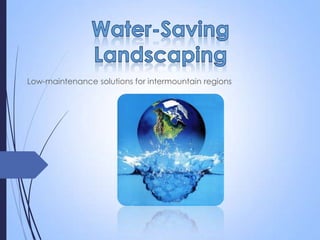Hcd p12-karem mendoza- practica#13- animacion y exportacion de diapositivas
- 1. Low-maintenance solutions for intermountain regions
- 2. 2 ’é┤ Hot temperatures ’é┤ Cold temperatures ’é┤ Shorter growing season ’é┤ Drying winds ’é┤ Deluge/drought ’é┤ Poor soil Water-Saving Landscaping April 18, 2010
- 3. 3 ’é┤ Windbreaks ’é┤ Xeriscaping ’é┤ Soil amendment ’é┤ Native plants Water-Saving Landscaping April 18, 2010
- 4. 4 ’é┤ Structures ’é┤ Fences ’é┤ Walls Water-Saving Landscaping April 18, 2010
- 5. Windbreaks 5 ’é┤ Plants ’é┤ Tree lines ’é┤ Hedges Water-Saving Landscaping April 18, 2010
- 8. 8 Activity Average Conservative Brushing teeth 2 0.5 Washing hands 2 0.5 Toilet flush 5 2 Shaving 10 1 Shower (8 min.) 20 5 Bath 36 15 Dishwasher 15 7 Dishes by hand 20 5 Clothes washer 40 25 Lawn (20 min.) 200 200 Water-Saving Landscaping April 18, 2010
- 9. 9 ’é┤ Planting strategies that conserve water Water-Saving Landscaping April 18, 2010
- 10. 10 ’é┤ No additional watering Water-Saving Landscaping April 18, 2010
- 11. 11 ’é┤ Drip irrigation Water-Saving Landscaping April 18, 2010
- 12. 12 ’é┤ Eastern Washington loses more than 10 tons of soil per acre per year to rainfall runoff Water-Saving Landscaping April 18, 2010
- 13. 13 ’é┤ Tolerate temperature range ’é┤ Tolerate drought ’é┤ Prevent erosion ’é┤ Support natural ecosystem ’é┤ Attract pollinators ’é┤ Need little or no maintenance ’é┤ Sustainable Water-Saving Landscaping April 18, 2010
- 14. 14 Seasonal Temperatures Winter Spring Summer Fall Minimum 18 41 73 43 Average 29 57 89 54 Maximum 40 72 105 65 Water-Saving Landscaping April 18, 2010
- 16. 16 Photos courtesy of Rugged Country Plants Water-Saving Landscaping April 18, 2010
















